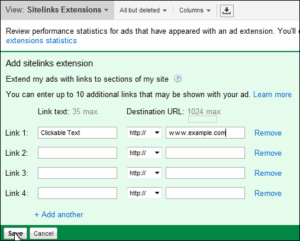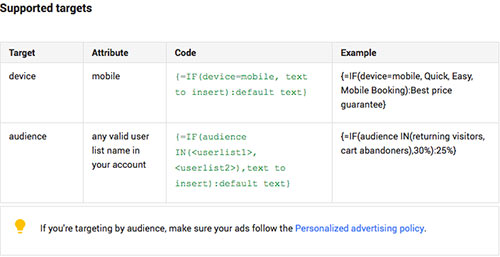Still, an ad’s headline remains its most important feature. Within your text ad, your description line, display URL, and ad extensions only exist to complement the headlines.

Where are your eyes drawn to in the ad above? Chances are, the headline demands your attention. In fact, many online searchers all but ignore the other text in the ad. Don’t get us wrong; it’s important to take up the additional real estate (such as using ad extensions, which improve overall headline CTR), but most folks click on your ad based on the message delivered in your headline.
So what goes into a killer headline?
It’s important to include your targeted keyword(s) and call to action, as well as any competitive differentiators, promos, or urgency messaging if space allows it. In other words, don’t save your most important messaging for the non-header text.
But again, we go back to stressing that the rest of your ad has importance. We’re not devaluing the description and ad extensions. These components must be relevant.
If, for example, we were bidding on “urgent care” I might consider testing two ads with variances on “fast and convenient”:
- Ad #1: Urgent Care – Doctors on Demand
- Ad #2: Get Urgent Care Immediately – Doctors on Hand 24/7
Our description line could then be: Urgent care open 7 days a week. No appointment necessary. Walk-in today!
The description includes relevant messaging that offers some value to the searcher, but they could certainly make a decision without it.

To take a step further, we’d fill out the rest of our ad space. For example, sitelinks for an urgent care ad could be:
- Contact Us
- Our Services
- Find a Doctor
- Classes & Events
The ad should then also provide the address, phone number, and hours of operation of the clinic.
All the text is necessary to have, but it’s clear that the headline rules the roost.
Factoring in your audiences
Ideally, you’ll create a different message for each audience. For example, someone who visited your site repeatedly will see one message, while a new searcher would see a different one. For Remarketing Lists for Search Ads (RLSA), you can create a new campaign which shows a different message, or you can layer an audience to an existing campaign and bid higher.
We’d typically recommend creating the new campaign so you are guaranteed to show the correct message and it’s easier to segment your data, but AdWords recently rolled out IF Functions. IF Functions allows you to change ad messaging based on the device a searcher is using. For example, someone on an iPhone might see an ad that says “Call one of our doctors now” while on a desktop they’d see “Walk-ins welcome.”

Thanks to IF Functions, you can now create one ad that showcases a different message for each audience. That searcher who’s already visited your site may be given a “welcome back” message, while a new searcher views an ad that speaks to the variety of services the clinic offers. As a result, one of the main reasons why you’d normally have created an RLSA campaign has all but been negated since the ad is customized for the specific audience.
You could still argue that an RLSA-only campaign allows you to bid on broader keywords since the searcher has already been to the site. Your decision will depend on the data and personal preference. The takeaway is that it’s now easier to customize your ads per audience.
Another factor to consider for your audience segmentation is demographics. You could create unique ad groups per age and/or gender. So, if you want a younger group (say, 18-24-year-olds) to see a specific message, you’d create an ad group targeting this age range and set a bid modifier of -100% for the other ranges. Your keyword bids would then be unique for that age range.
Your targeted 25–34 age ad group would then have the other age ranges set at -100% and so forth.
Alas, there are two issues we see with this type of segmentation. First, you have the potential of drowning in the number of ad groups you’ve created (and have to manage). Granular segmentation makes sense if you have enough search volume or have a specific reason to go deeper, which comes to the second issue:
Google still only captures roughly 50 percent of demographic data. Everything else is classified as unknown. You don’t want to go more granular and make concrete decisions with a limited amount of data. Nonetheless, it may be worth testing with an ad group that has a good amount of data.
Summing it up
After years of delivering PPC management services, we’ve learned that there is no cookie cutter approach to ad writing. Even though since the beginning of time different audiences viewed ads, the ability to craft custom messaging for each audience hasn’t always been available (thanks, Google!). As these options roll out, it’ll be worth your while to use them to give your audiences more relevant, targeted ads.

